Ever dreamed of blending in with the locals in a charming Italian region? Welcome to Abruzzo, Italy’s best-kept secret! As a born-and-bred Pescarese, I’m here to let you in on the insider Abruzzo local tips that’ll transform your visit from tourist to temporary local.
Did you know that Abruzzo, despite its breathtaking beauty, receives only a fraction of Italy’s tourists? That’s great news for you! From the sun-soaked beaches of my hometown, Pescara, to the medieval alleys of Penne, where I now own a home, I’ve gathered 15 essential tips to help you experience the real Abruzzo.
These aren’t your typical tourist tricks. Instead, they’re the unwritten rules and cherished habits that define our way of life. Whether mastering the art of la passeggiata, savoring arrosticini like a pro, or navigating our local markets, these tips will help you dive deep into Abruzzese culture.
So, are you ready to trade the guidebook for a genuine Abruzzo experience? Let’s embark on this journey together, and I’ll show you how to live, eat, and celebrate like a true Abruzzese. Trust me, by the end of your trip, you might just be mistaken for a local!
- 1. Embracing "La Passeggiata": The Evening Stroll Ritual
- 2. Savoring Arrosticini: The Art of Eating Abruzzo's Favorite Skewers
- 3. Observing Riposo: The Sacred Midday Break
- 4. Celebrating Patron Saint Festivals: A Town's Biggest Party
- 5. Speaking Dialect: The Language of the Heart
- 6. Foraging for Nature's Bounty: From Truffles to Wild Herbs
- 7. Preserving Traditions: Homemade Passata and Sausages
- 8. Gathering at the Local Bar: More Than Just Coffee
- 9. Attending Sunday Lunch: Family Gatherings and Feast Days
- 10. Supporting Local Markets: From Produce to Artisanal Crafts
- 11. Embracing Slow Food: The Abruzzo Way of Eating
- 12. Appreciating Craftsmanship: From Textiles to Ceramics
- 13. Enjoying Outdoor Living: From Beach to Mountain
- 14. Preserving the Trabocchi: Fishing Traditions Along the Coast
- 15. Cultivating Wine Passion: More Than Just Montepulciano
- Wrapping Up
- Before You Go…
- Related Articles and Pages
1. Embracing “La Passeggiata”: The Evening Stroll Ritual

When and where to join the locals for this daily social custom
Ah, la passeggiata! It’s not just a walk; it’s the heartbeat of Abruzzese life. I remember my first real passeggiata as a little boy in Pescara. My parents dragged me along Corso Umberto I, and I thought, “Walking? For fun?” But man, was I wrong!
The street buzzed with energy. People of all ages, dressed in their casual best, filled the sidewalks. It was like a living, breathing social network.
Here’s an Abruzzo local tip: passeggiata usually happens between 5 and 8 PM, later in summer. In Penne, my second home, it often starts after dinner, around 9 PM.
The key is to take it slow. Stroll, pause, chat. I once tried to rush through and got so many weird looks! It’s about seeing and being seen, not getting your steps in.
Each season brings a different vibe. Spring is all about shedding winter coats, while summer often ends with gelato. Fall gets cozy, and winter? That’s when you spot the die-hards.
So, join in! Dress neat (no gym clothes!), greet folks with a “buonasera,” and be ready to chat. It’s the best way to feel the pulse of Abruzzo.
2. Savoring Arrosticini: The Art of Eating Abruzzo’s Favorite Skewers
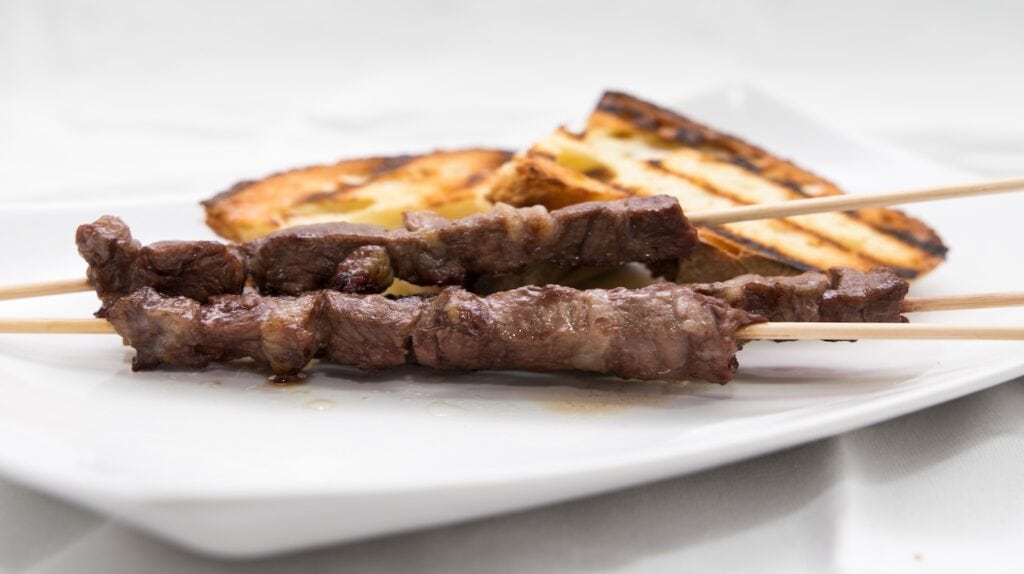
How to eat arrosticini like a true Abruzzese
Let me tell you about arrosticini, the pride of Abruzzo’s cuisine. These lamb skewers might look simple, but they’re a cultural icon. My first arrosticini experience? I was just a kid at a family gathering in Pescara, or at least that is the one I remember. The smell of grilling lamb on that long, narrow fornacella grill was unforgettable.
Here’s an Abruzzo local tip: the best arrosticini are often found in the most unassuming places. Forget fancy restaurants—look for small, family-run trattorias or even roadside stands. In Pescara, there’s this little shack near the beach that serves amazing arrosticini. Locals line up for hours! However, my absolute favorite is “Da Stefano,” near Penne, on the way to the mountains.
Now, eating arrosticini is an art form. First rule: no forks allowed! Grab the skewer by the wooden end and use your teeth to slide the meat off. I once saw a tourist try to eat them with a knife and fork – the horror on locals’ faces was priceless!
The secret? Savor those crispy, fatty bits between the meat. They’re flavor bombs! Just be careful not to burn your tongue in excitement. Trust me, I’ve done that more times than I care to admit.
Pair your arrosticini with chunks of rustic bread and a glass of Montepulciano d’Abruzzo wine. It’s a match made in culinary heaven. And don’t be shy – putting away 20 or 30 skewers in one sitting is normal. It’s all part of the Abruzzo experience!
3. Observing Riposo: The Sacred Midday Break
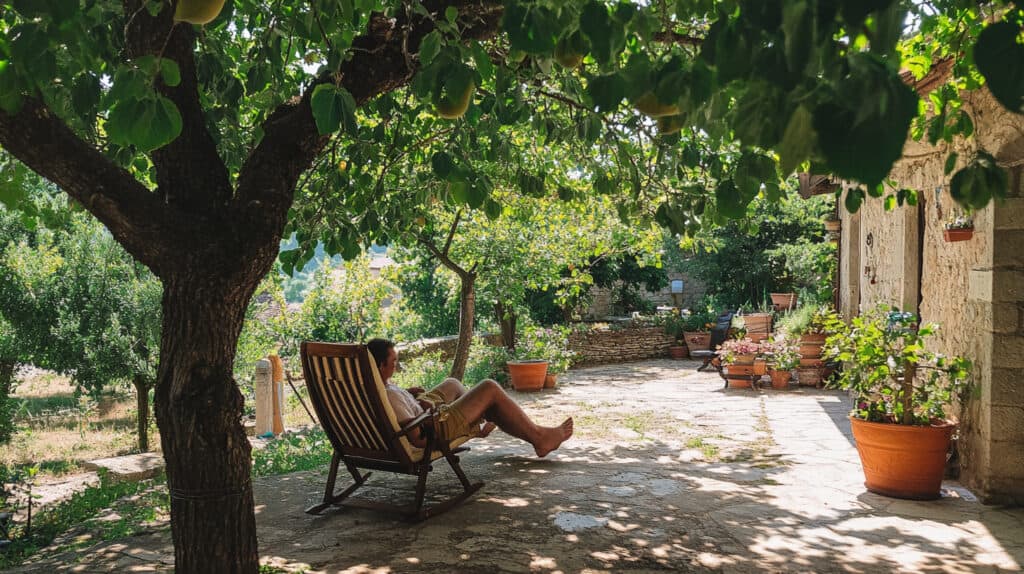
Understanding business hours and meal times in Abruzzo
Riposo, our midday break, is something that often catches visitors off guard. It’s not just a lunch break; it’s a way of life here in Abruzzo. I remember when I first returned from living abroad, I’d forgotten all about it. I stood in front of a closed shop in Pescara at 2 PM, hungry and confused!
Here’s an essential Abruzzo local tip: most businesses close between 1 PM and 4 PM. This isn’t just for small shops; even some larger stores observe riposo. Plan your day around it, or you might find yourself wandering empty streets, wondering where everyone went.
Riposo is more than just closing shop. It’s about taking time to enjoy a leisurely lunch, maybe catch a quick nap, and escape the midday heat. In my hometown of Penne, the streets are so quiet during riposo that you can hear the church bells echoing through the empty piazzas.
For visitors, this can be a great time to do as the locals do. Find a lovely trattoria, sit down for a long lunch, and don’t rush. I love taking friends to my favorite spot in Penne during riposo. We’ll spend hours over pasta, wine, and conversation. It’s the Abruzzese way!
Remember, dinner in Abruzzo starts late, usually around 8 PM or later. So use riposo to fuel up for the evening. And if you’re invited to someone’s home for lunch during riposo, clear your schedule. You’re in for a treat and probably won’t leave until dinner time!
4. Celebrating Patron Saint Festivals: A Town’s Biggest Party

How to participate respectfully in local religious celebrations
Patron saint festivals in Abruzzo are like nothing you’ve ever seen. They’re a mix of religious devotion, cultural pride, and, let’s be honest, a great excuse for a party. I’ll never forget my first festa as a kid in Pescara, celebrating Sant’Andrea. The streets were alive with music, food stalls, and palpable excitement.
Here’s a local tip for Abruzzo: These festivals aren’t just for the religious. They’re a time when the whole community comes together. Even if you’re not Catholic, you’re more than welcome to join in the festivities.
Each town has its own unique traditions. In Penne, where I have my second home, the festival of San Massimo in May is a sight. The highlight is the procession where the saint’s statue is carried through the streets. I once had the honor of helping carry the statue – it’s heavier than it looks!
If you’re visiting during a festival, here’s how to participate respectfully:
- Dress modestly if you plan to enter churches.
- Follow the crowd during processions, but don’t block the path.
- Try the traditional foods – each festa has its specialties.
- Join in the evening entertainment, often featuring music and fireworks.
Remember, these festivals are a source of pride for locals. Show genuine interest, ask questions, and you’ll likely end up making new friends. I once struck up a conversation with a gentleman on his late 70s at a festival in Sulmona, and ended up getting a personal history lesson about the town’s traditions.
Lastly, be prepared for late nights. The real party often starts after the religious ceremonies are over. And trust me, Abruzzesi know how to celebrate!
5. Speaking Dialect: The Language of the Heart
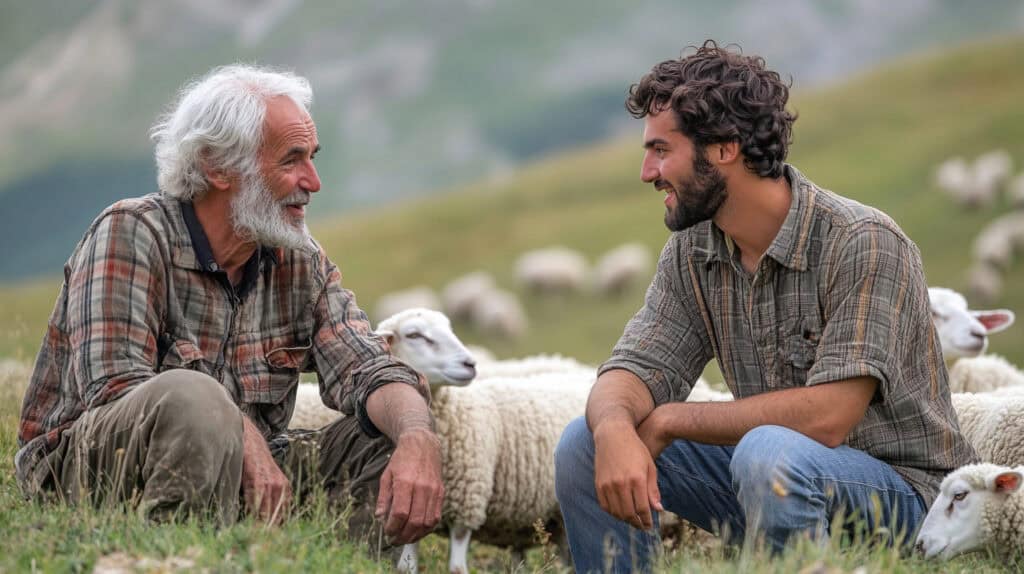
Essential Abruzzese phrases to connect with locals
Ah, the Abruzzese dialect! It’s like music to my ears, a language that speaks straight to the heart. Growing up in Pescara, I thought I knew Italian pretty well. But when I visited my relatives in a small village called Alanno, I realized I had much to learn!
Here’s an Abruzzo local tip: even a few words of dialect can open doors and hearts. Locals light up when they hear visitors attempt our unique expressions. It shows you’re making an effort to understand our culture.
Let me share some essential phrases:
- “Che bbelle!” (How beautiful!) – Use this for everything from a sunset to a plate of pasta.
- “Jàmma jà!” (Let’s go!) – Perfect for rallying your friends to the next bar.
- “Sté bbòne?” (Are you well?) – A friendly way to greet someone.
I once impressed a group of older men playing cards in Penne by saying, “Quante sì ‘bbille!” (How handsome you all are!). They laughed so hard, they invited me to join their game.
Don’t worry about perfect pronunciation. The effort is what counts. I’ve seen tourists stumble through phrases and still be rewarded with beaming smiles and extra helpings of food.
Remember, dialect varies even within Abruzzo. What works in Pescara might sound a bit different in L’Aquila. But that’s part of the fun – each conversation is a new learning experience.
So, give it a try! You might fumble, you might make mistakes, but I guarantee you’ll create memorable connections with the warm-hearted people of Abruzzo.
6. Foraging for Nature’s Bounty: From Truffles to Wild Herbs
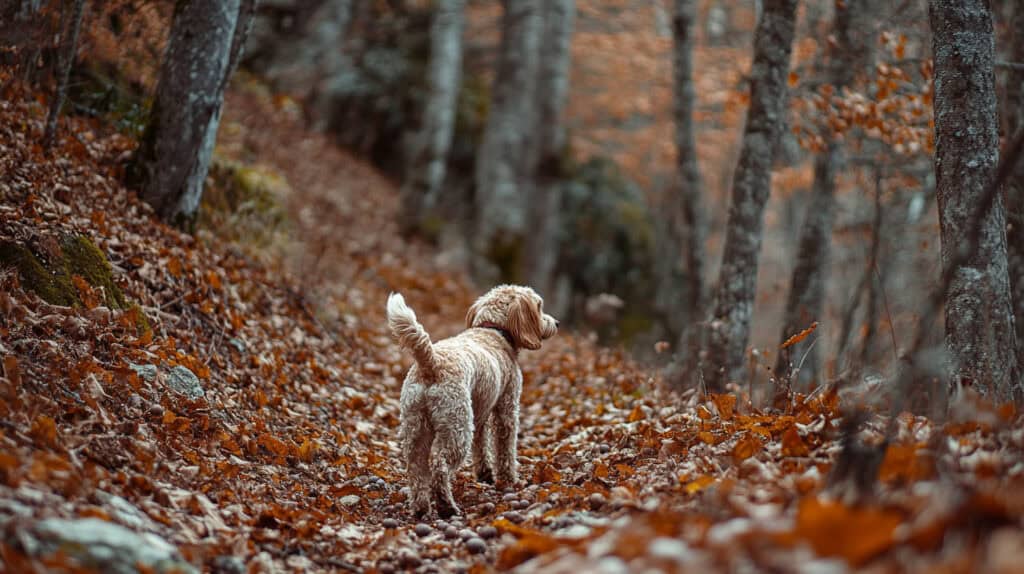
Popular foraging spots and seasonal delicacies
Foraging is more than just a hobby in Abruzzo; it’s a way of life that connects us to our land. I grew up watching my nonno head into the hills around Alanno, returning with baskets full of nature’s treasures. It’s a tradition I’ve come to love and appreciate even more as I’ve grown older.
Here’s an Abruzzo local tip: each season offers different foraging opportunities. Spring brings wild asparagus and tender greens. Summer is perfect for berries and wild herbs. Fall? That’s when the real excitement begins with mushroom hunting and truffle foraging.
I remember my first mushroom hunt in the Majella National Park. I was so excited to find what I thought was a porcini, only to have “nonno” Tonino gently explain it was inedible. Lesson learned: always go with an expert until you know what you’re doing!
Popular foraging spots include:
- The hills around Penne for wild herbs and berries
- Majella National Park for mushrooms (with a permit)
- The woods near L’Aquila for truffles (go with a licensed guide and their dogs)
Remember, foraging comes with responsibilities. Take only what you need, respect nature, and always check local regulations. Some areas require permits, especially for mushrooms and truffles.
One of my favorite memories is joining a truffle hunt near San Valentino. The thrill of watching the dogs sniff out those precious tubers is unmatched. And the pasta with fresh truffles afterward? Mamma mia, it’s heaven on a plate!
Whether you’re an experienced forager or just curious, Abruzzo’s wild bounty offers a unique way to connect with our region’s natural heritage. Just be prepared for some odd looks if you get too excited about finding wild chicory – trust me, I’ve been there!
7. Preserving Traditions: Homemade Passata and Sausages
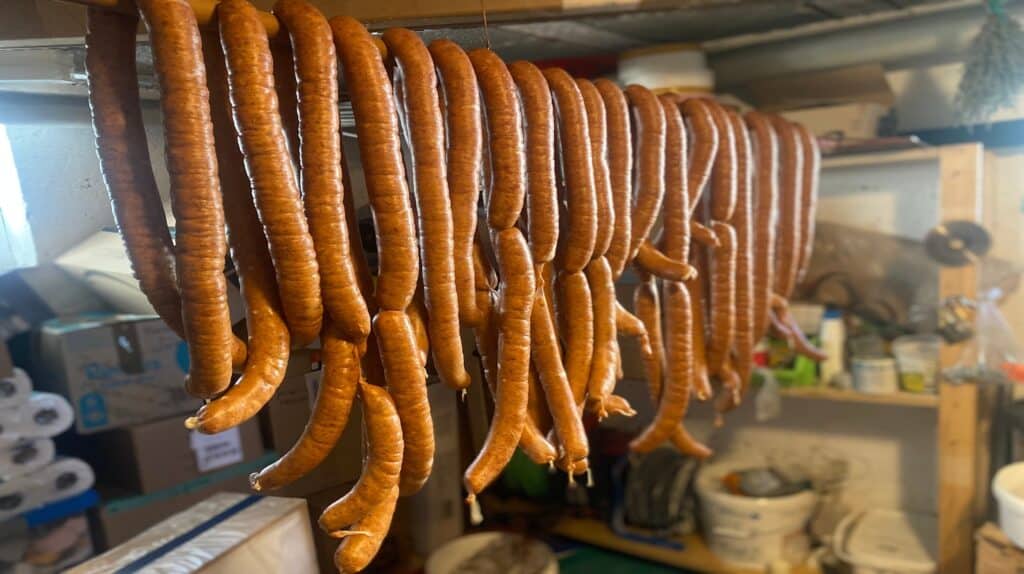
Joining in on seasonal food preparation rituals
In Abruzzo, food preservation isn’t just about stocking up; it’s a cherished ritual that brings families and communities together. I have fond memories of helping my nonna (and the rest of the family) make passata in Pescara every August. The whole family would gather, turning mountains of ripe tomatoes into jars of ruby-red sauce that would last us through winter.
Here’s an Abruzzo local tip: if you’re invited to join a family’s food preparation day, jump at the chance! It’s a unique way to experience our culture and maybe learn a secret recipe or two.
The passata-making process is a well-choreographed dance. Everyone has a role – washing tomatoes, feeding them into the hand-cranked machine, stirring the bubbling pots. I once got so enthusiastic with the crank that I sent tomato pulp flying everywhere! My cousins still tease me about it.
Sausage-making is another winter tradition. In Fara Filiorum Petri, I’ve joined friends for their annual sausage day. It’s a festive affair, with wine flowing as freely as the jokes. The art of mixing spices and stuffing casings is passed down through generations.
Other seasonal preparations include:
- Drying peppers for peperonata in late summer
- Preserving vegetables in oil (sott’olio) in autumn
- Making vin cotto (cooked wine) during grape harvest
These rituals are more than food prep; they’re a way of keeping our heritage alive. Plus, there’s nothing quite like opening a jar of homemade passata in the depths of winter – it’s like tasting summer sunshine!
Remember, patience is key in these activities. Rush the process, and you’ll likely hear a chorus of “piano, piano!” (slowly, slowly!) from the elders. Trust me, I learned that lesson the hard way!
8. Gathering at the Local Bar: More Than Just Coffee

The social importance of the neighborhood caffè
In Abruzzo, the local bar is the beating heart of social life. It’s not just about getting your morning espresso; it’s where the community comes together. I remember my first solo visit to our neighborhood bar in Pescara as a teenager. I felt so grown-up ordering my caffè and lingering like the adults!
Here’s an Abruzzo local tip: the bar is where you’ll get the real pulse of a town. Want to know what’s happening? Just spend an hour at the bar, and you’ll be up to date on everything from local gossip to political debates.
The ritual is simple but essential. You order at the counter, knock back your espresso quickly (sitting down costs more!), and then join in the chatter. One visiting friend (not Italian) once made the mistake of ordering a cappuccino after 11 AM. The barista’s raised eyebrow taught him that’s a breakfast-only drink here!
Bars serve different purposes throughout the day:
- Morning: Quick espresso and cornetto for breakfast
- Midday: Light lunch and catching up on news
- Evening: Aperitivo time with snacks and drinks
One of my favorite memories is watching World Cup matches at the bar in Penne. The whole town seemed to cram into this tiny space, cheering for Italy. The energy was electric!
Remember, loyalty to your local bar is important. Abruzzesi often have “their” bar where they’re known by name. Don’t be surprised if the barista starts preparing your usual order as soon as you walk in.
And if you’re invited for an aperitivo by locals, accept! It’s a great way to make friends and practice your Italian. Just be prepared for lively discussions – Abruzzesi are passionate debaters, especially over calcio (football)!
9. Attending Sunday Lunch: Family Gatherings and Feast Days

What to expect if you’re invited to an Abruzzese family meal
Sunday lunch in Abruzzo isn’t just a meal; it’s an event. Growing up in Pescara, I looked forward to these weekly feasts at my nonna’s house. The aromas wafting from her kitchen would draw us in long before the official start time.
Here’s an Abruzzo local tip: if you’re invited to a Sunday lunch, clear your schedule for the entire afternoon. These meals are marathons, not sprints!
The typical Sunday lunch usually unfolds like this:
- Antipasti: An array of cured meats, cheeses, and marinated vegetables
- Primo: Often a hearty pasta dish like chitarra all’amatriciana
- Secondo: A meat course, perhaps arrosticini or braised lamb
- Contorni: Various vegetable side dishes
- Dolce: Homemade desserts like pizzelle or crostata
I once made the rookie mistake of filling up on antipasti at my first Sunday lunch in Penne. By the time the pasta arrived, I was already stuffed. But refusing food is not an option – nonna will insist you eat more! We have a saying here in Abruzzo, which I love: “Meglio che ci avanza, non che ci manca”. It literally means “Better that we have leftovers, not that we lack it”.
Conversation flows as freely as the wine. These gatherings are perfect for catching up on family news, debating current events, or reminiscing about the old days. I’ve learned some of the best family stories over these long lunches.
If you’re invited as a guest, bring a small gift like wine or dessert. And come hungry – very hungry. Complimenting the cook is essential, but be prepared for modest deflections. My nonna always said, “Oh, it’s nothing special,” even when she’s spent hours preparing a feast fit for royalty.
Remember, patience is key. These meals can last for hours, so settle in and enjoy the experience. It’s not just about the food; it’s about the joy of being together.
10. Supporting Local Markets: From Produce to Artisanal Crafts
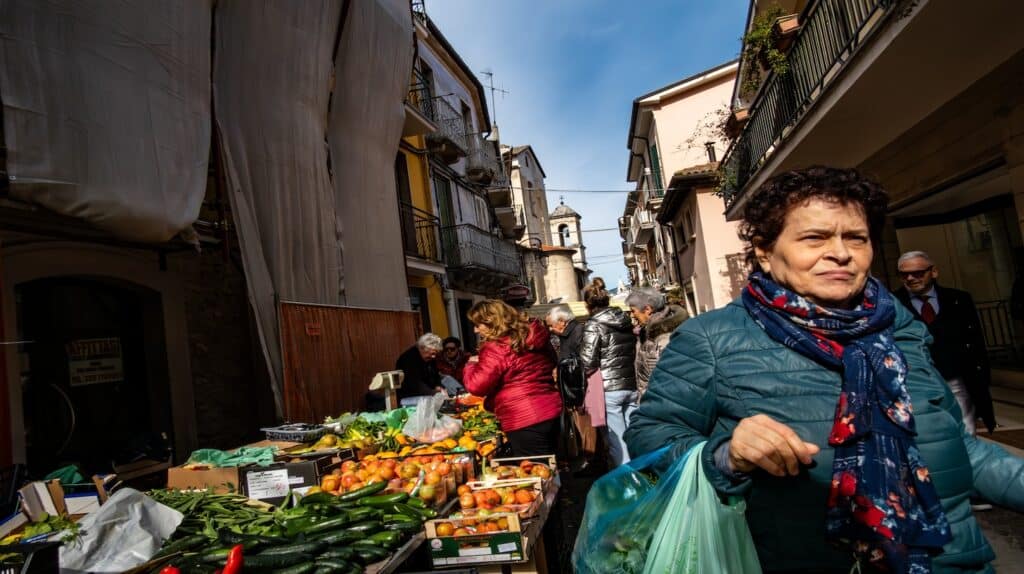
Navigate weekly markets like a seasoned local
The local markets in Abruzzo are a feast for the senses and a window into our culture. I’ve been a market enthusiast since I was knee-high, tagging along with my nonna in Pescara. The colors, sounds, and smells still excite me every time I visit.
Here’s an Abruzzo local tip: arrive early for the best selection. I learned this the hard way when I once slept in and missed out on some coveted homemade cheeses in Penne’s market.
Navigating our markets like a local:
- Bring your own bags – it’s eco-friendly and very Abruzzese
- Don’t be shy about asking for samples, especially for cheeses and olives
- Haggle gently for non-food items, but respect set prices for produce
- Look for seasonal specialties – each visit is like a culinary calendar
I remember my first solo trip to the market as a young adult. I confidently asked for “peperoni” (peppers) and was handed a bunch of chili peppers instead of the sweet bell peppers I wanted. It was a spicy lesson in Italian vocabulary!
Markets aren’t just for food. You’ll find artisanal crafts too. In Pescara’s market, there’s a stall selling beautiful handmade linens. Years ago, I bought a tablecloth that still graces my table for special occasions.
One of my favorite market experiences happens in fall, during the olive harvest. The air is filled with the peppery scent of freshly pressed olive oil. Watching locals carefully select their year’s supply is a serious business – after all, good olive oil is the foundation of Abruzzese cuisine!
Remember, markets are social hubs. Take your time, chat with vendors, and soak in the atmosphere. It’s not just shopping; it’s an authentic slice of Abruzzese life.
11. Embracing Slow Food: The Abruzzo Way of Eating

Understanding the region’s food philosophy and practices
In Abruzzo, we don’t just eat food; we celebrate it. Our approach to cuisine is deeply rooted in the Slow Food movement, though we’ve been practicing it long before it had a fancy name. Growing up in Pescara, every meal felt like a mini-celebration of our local bounty.
Here’s an Abruzzo local tip: never rush your meals. Eating slowly isn’t just about savoring flavors; it’s about connecting with your food and your dining companions.
Key aspects of Abruzzo’s slow food philosophy:
- Seasonality: We eat what’s fresh and local
- Simplicity: Few ingredients, prepared with care
- Tradition: Recipes passed down through generations
- Sustainability: Using every part of the animal or plant
I remember my first attempt at making pasta alla chitarra in Penne. The process took hours, but the result was worth every minute. The texture and flavor were incomparable to anything store-bought.
Our Sunday lunches epitomize slow food. These multi-course affairs can last for hours, giving each dish its due appreciation. I once mistakenly checked my watch during one of these meals at some friend’s nonna’s. Her disapproving look taught me to leave timepieces at the door!
Abruzzo’s commitment to slow food extends beyond the table. We have numerous Presidia projects protecting traditional products like Solina wheat and Campotosto mortadella. These initiatives ensure our food heritage isn’t lost to industrialization.
Remember, embracing slow food in Abruzzo means more than just eating. It’s about respecting the land, the producers, and the traditions that make our cuisine unique. So take your time, ask about the origins of your food, and most importantly, enjoy every bite!
12. Appreciating Craftsmanship: From Textiles to Ceramics

Where to find and how to appreciate local artisanal work
Abruzzo’s artisanal traditions are as rich and varied as our landscapes. Growing up in Pescara, beautiful handcrafted items surrounded me, but it wasn’t until I moved away that I genuinely appreciated their value. Now, exploring local crafts is one of my favorite things to do when I return home.
Here’s an Abruzzo local tip: the best artisanal pieces are often found in small workshops, not tourist shops. Don’t be afraid to venture off the beaten path to find them.
Key artisanal traditions in Abruzzo:
- Ceramics from Castelli: Known for intricate designs and vibrant colors
- Textiles from Pescocostanzo: Delicate lace and fine embroidery
- Woodcarving from the Majella area: Rustic and beautiful household items
- Jewelry from Scanno: Unique designs inspired by traditional costumes
I’ll never forget my first visit to a ceramics workshop in Castelli. The artisan let me try painting a small plate. Let’s just say I gained a whole new respect for their skill and patience!
When appreciating Abruzzese crafts, take time to understand the process. Many artisans are happy to explain their techniques if you show genuine interest. In Penne, I once spent an entire afternoon watching a local weaver work her loom. It was like witnessing living history.
Look for workshops that offer demonstrations or short courses. I took a one-day lace-making class in Pescocostanzo. My attempts were far from perfect, but the experience gave me a deep appreciation for this intricate art.
Remember, buying artisanal products isn’t just about taking home a souvenir. It’s about supporting centuries-old traditions and the skilled craftspeople who keep them alive. So when you find that perfect piece, know that you’re taking home a little piece of Abruzzo’s heart and soul.
13. Enjoying Outdoor Living: From Beach to Mountain
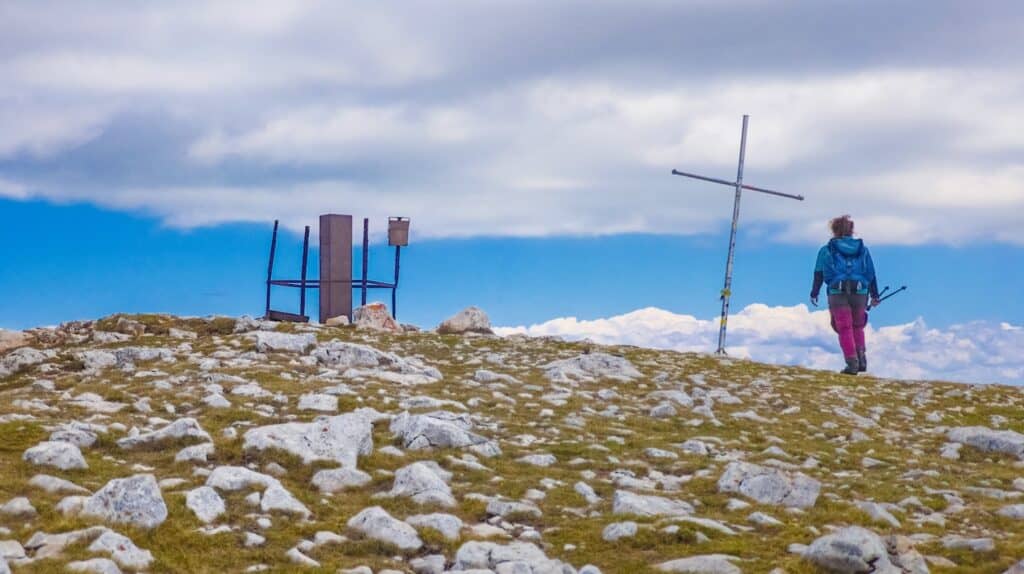
Seasonal outdoor activities favored by locals
In Abruzzo, we live our lives outdoors as much as possible. With the Adriatic coast on one side and the Apennine mountains on the other, there’s always something to do outside, no matter the season. Growing up in Pescara, I had the best of both worlds right at my doorstep.
Here’s an Abruzzo local tip: always be prepared for outdoor adventures. I keep a “go bag” with swimwear, hiking shoes, and a light jacket in my car year-round.
Favorite seasonal activities:
- Summer: Beach days in Pescara, hiking in Majella National Park
- Autumn: Grape harvesting, mushroom foraging in the hills near Penne
- Winter: Skiing in Roccaraso, snowshoeing in Campo Imperatore
- Spring: Wildflower walks in Gran Sasso, cycling along the costa dei trabocchi
I remember my first attempt at skiing in Roccaraso. Let’s just say I spent more time on my backside than upright! But the thrill of gliding down those slopes (eventually) was unbeatable.
Abruzzesi take their outdoor time seriously. On summer Sundays, it seems like all of Pescara empties onto the beach. I’ve learned to arrive early to claim a good spot, especially near the clearest water at La Madonnina beach.
Don’t miss the opportunity to join locals in seasonal activities. Helping with the olive harvest can be hard work, but the satisfaction of pressing your own oil is worth every aching muscle.
Remember, in Abruzzo, nature isn’t just something to look at – it’s something to experience fully. So pack your sense of adventure and get ready to embrace the great outdoors, Abruzzese style!
14. Preserving the Trabocchi: Fishing Traditions Along the Coast

Experiencing these unique fishing platforms like a local
The trabocchi, those spindly wooden fishing platforms jutting out into the Adriatic, are icons of Abruzzo’s coastline. Growing up in Pescara, I always saw them as magical structures, like something out of a fairy tale. It wasn’t until I was older that I truly appreciated their significance to our cultural heritage.
Here’s an Abruzzo local tip: the best way to experience a trabocco is to dine on one. Many have been converted into restaurants, offering an unforgettable seafood experience.
Key things to know about trabocchi:
- They’re ancient fishing machines, some dating back centuries
- Each trabocco is unique, built and maintained by local families
- They’re mostly found along the Costa dei Trabocchi, south of Pescara
- Some still function as working fishing platforms
I’ll never forget my first meal on a trabocco near San Vito Chietino. The fresh catch of the day, cooked simply with local olive oil and herbs, tasted like the essence of the sea. The gentle creaking of the wood beneath us added to the magical atmosphere.
If you’re lucky, you might see a trabocco in action. I once watched fishermen lower the giant nets at sunset. The skill and teamwork required were impressive – it’s an art passed down through generations.
For a deeper understanding, consider taking a guided tour. I did this in Fossacesia and learned fascinating details about the trabocchi’s history and construction. The guide’s passion for preserving this tradition was contagious.
Remember, the trabocchi are more than just picturesque photo opportunities. They represent Abruzzo’s enduring connection to the sea. So when you visit, take a moment to appreciate the craftsmanship and the generations of fishermen who’ve kept this tradition alive.
15. Cultivating Wine Passion: More Than Just Montepulciano

How locals enjoy and celebrate their regional wines
Wine isn’t just a drink in Abruzzo; it’s a way of life. Growing up in Pescara, I remember how my father would carefully select wines for our Sunday lunches, treating each bottle with reverence. It wasn’t until I was older that I truly appreciated the rich wine culture of our region.
Here’s an Abruzzo local tip: don’t just stick to Montepulciano d’Abruzzo. While it’s our flagship wine, we have many other varieties worth exploring.
Key aspects of Abruzzo’s wine culture:
- Montepulciano d’Abruzzo: Our bold, robust red
- Trebbiano d’Abruzzo: A crisp, refreshing white
- Cerasuolo d’Abruzzo: A distinctive rosé with character
- Pecorino: An ancient white variety making a comeback
I’ll never forget my first proper wine tasting in a cantina near Penne. The vintner taught me to swirl, sniff, and sip, opening up a whole new world of flavors and aromas. It was like learning a new language!
Abruzzesi take pride in pairing wine with food. I once made the faux pas of serving white wine with arrosticini at a family gathering. My uncle gently corrected me, explaining how the tannins in red wine complement the rich lamb flavor.
Don’t miss the opportunity to visit local vineyards. Many offer tours and tastings. I spent a memorable afternoon at a small family-run vineyard in Controguerra, learning about their organic winemaking process.
Remember, wine in Abruzzo is about more than just drinking. It’s about connection – to the land, to tradition, and to each other. So raise a glass, savor the flavors, and toast to the rich wine heritage of our beautiful region. Salute!
Wrapping Up
Armed with these Abruzzo local tips, you’re now ready to explore our beautiful region authentically. From savoring our delicious cuisine to discovering hidden gems, these insights will transform your Abruzzo adventure. Remember, the key to truly experiencing our region is to slow down, embrace our relaxed lifestyle, and connect with the friendly locals.
Whether you’re lounging on Pescara’s beaches or wandering through Penne’s historic streets, Abruzzo will capture your heart just as it’s always held mine. So, what are you waiting for? Start planning your authentic Abruzzo experience today. And when you arrive, don’t forget to raise a glass of Montepulciano and say “Salute!” Buon viaggio!
Before You Go…
If you want to know more about Abruzzo, this beautiful region of Italy, you can read another article I wrote:
15 Compelling Reasons Why You Should Visit Abruzzo in Italy

